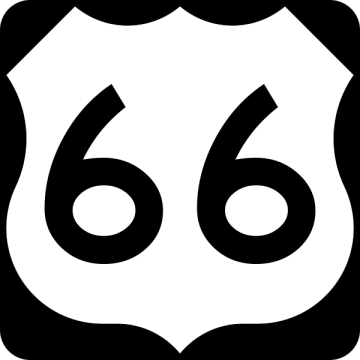Tags
616, 616 East Lincoln Avenue, Competition, Happy Birthday, Intervention, Jealousy, Life, Mom, Mother-Son Relationship, Sharing, Silence, Trust

U.S. Route 66 shield, made to the specifications of the 2004 edition of Standard Highway Sign, January 27, 2006. (SPUI via Wikipedia). Released to public domain.
Today was my Mom’s sixty-sixth birthday. I’m just beginning to come to grips with the fact that Mom’s a senior citizen, considering that she was only twenty-two when she had me in ’69. It’s been a roller coaster ride through hell, with many downs and only a handful of ups over those years. The one casualty in those years that we haven’t overcome has been the ability to share everything that has been my life with her, especially in the last decade.
I learned the hard way sixteen years ago that the lack of distance in age between me and Mom resulted in a sort-of competition. It was one of which I hadn’t been aware until ’97. It involved higher education, finding work and finding full-time work. It involved friendships and relationships, God and church, and finding a passion for a calling. Week after week, and year after year, from ’87 to ’02, I talked on the phone or at 616 with my Mom about these situations and issues. Only to find that my triumphs and failures were only a point of comparison for her, and not a conversation involving life and lessons.
When I finally realized this in ’97, and did an intervention involving my family on this and other issues in ’02, it was the third most emotionally painful thing I’d ever been through. I had to decide how I should talk to my Mom moving forward. I made the choice to not share significant parts of my life with Mom. From that point on, I chose to not discuss any victories or struggles in my jobs, in finding work, in consulting or teaching with her. Nor have I talked about my marriage’s ups and occasional downs, my writings, my publications, my projects, my hopes, my dreams, my fears, or my struggles. Mostly, I’ve only talked about my son and his glacial journey toward adulthood, the weather, my siblings, or something in the news that may be funny or relevant.

Ginsu 9-Inch Japanese Stainless Steel Slicer, October 28, 2013. (http://www.amazon.com).
This has been the case since the summer of ’02. Uncomfortable silences and frequent struggles to think about what to actually discuss that could have real meaning, have been what this has meant for the two of us. Given her response to the intervention I conducted in January ’02, I can only imagine what Mom’s response would be to Boy @ The Window. On the one hand, she would act unimpressed, as if I’d written a book about organic chemistry and nanotechnology. On the other hand, my Mom would likely be seething behind her ho-hum mask, ready to rip my throat out for airing family secrets and dirty laundry. (I actually dreamt as much the other night, being at a book talk with Mom coming over the table, slashing at me with a Ginsu knife).
I haven’t been angry with my Mom for years, and I forgave Mom for any mistakes she made regarding me growing up years ago. But I know my Mom well enough to know that our relationship could never be an adult mother-son one, where I get to be an adult and her son at the same time. Part of that means me remaining silent about a significant part of my life, including a memoir in which she’s a main character. It’s too bad, yet it’s also the way it must be. For my emotional sanity, as well as for hers.












